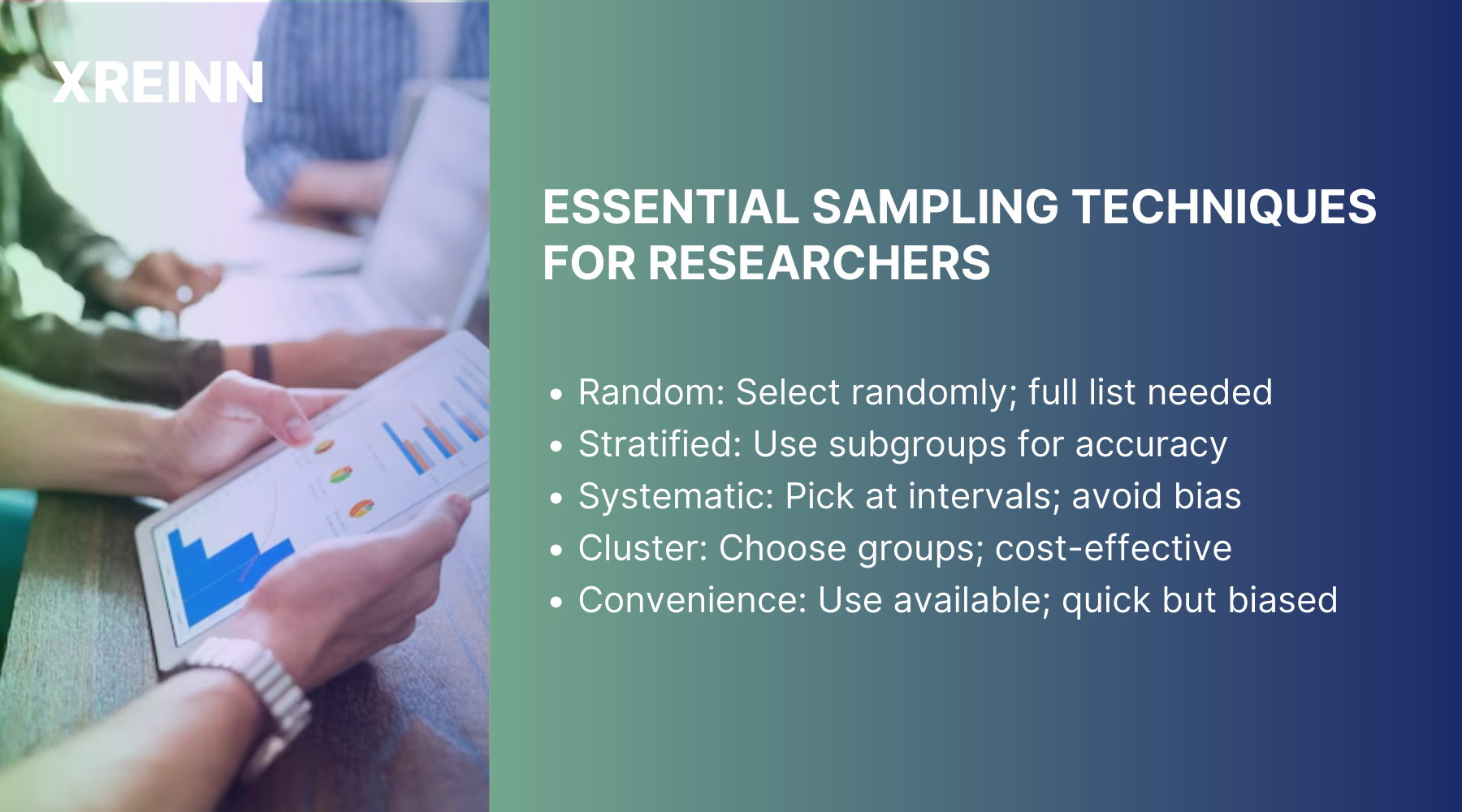Research
5 Sampling Techniques Every Researcher Should Know
Aug 02, 2024
A well-chosen sampling technique can significantly improve the credibility and impact of your research. In advanced research, selecting the right method is significant for producing results that accurately reflect the larger population. This choice plays a vital role in determining the validity and reliability of your findings, making it essential to understand the available options.
By using the appropriate sampling technique, you ensure your research withstands scrutiny and provides insights that truly reflect the population you are studying. Making this choice carefully improves the depth and quality of your study.
In this guide, you’ll learn about five key sampling techniques that can make your research more insightful and impactful.
Essential Sampling Techniques for Researchers

1. Random Sampling
Random sampling is the gold standard for achieving unbiased results. It operates on the principle that every member of the population has an equal chance of being selected. To implement this, you need a comprehensive sampling frame—a complete list of all individuals in your target population. You can then use a random number generator or software like Excel, R, or SPSS to select participants. These tools ensure that each selection is independent, minimizing bias.
In cases where a complete sampling frame is unavailable, you can adopt weighted random sampling to account for different probabilities of selection. Alternatively, stratified random sampling can help ensure that specific subgroups are proportionally represented, enhancing precision and reducing sampling error.
Applications
Random sampling is best in studies where high external validity is important. It is particularly effective in large-scale surveys, epidemiological studies, and any research where representativeness is needed. By ensuring each participant has an equal probability of selection, you increase the likelihood that your sample accurately reflects the broader population.
Advantages and Challenges
The primary advantage of random sampling is its ability to reduce selection bias, which improves the representativeness of your findings. However, it also presents challenges, such as the difficulty of creating a complete sampling frame, especially in large populations. Incomplete frames can lead to undercoverage, which affects your study's validity.
2. Stratified Sampling
Stratified sampling involves dividing your population into distinct subgroups or strata based on specific characteristics, such as age, gender, or income. Once these strata are identified, you sample from each group either proportionally or equally, depending on your research objectives. This approach ensures that each subgroup is represented in your sample, providing more detailed insights into the population.
To optimize stratified sampling, you must determine the optimal number of strata that balance detail with practicality. Consider employing multistage sampling, which combines stratified sampling with other techniques, to handle complex populations more efficiently.
Applications
This technique is invaluable when your study focuses on specific demographic differences or when subgroups within your population have varying behaviors or attributes. For instance, in market research, stratified sampling allows you to analyze consumer preferences across different age groups or income brackets, providing more nuanced insights.
Advantages and Challenges
Stratified sampling increases precision and reduces sampling error by ensuring each subgroup is adequately represented. However, determining the appropriate strata can be challenging, particularly when the population is heterogeneous. Additionally, managing data from multiple strata requires sophisticated analytical techniques to maintain accuracy.
3. Systematic Sampling
Systematic sampling involves selecting samples at regular intervals from a randomized list. First, you choose a starting point at random, then select every k-th element in your sampling frame, where k is the interval size. It's important to ensure that the list is randomized beforehand to prevent periodic patterns from introducing bias.
Integrating systematic sampling with other methods, such as stratified or cluster sampling, can improve strength and lessen potential biases. Adjust the sampling interval to account for population heterogeneity, ensuring that your sample remains representative despite underlying patterns.
Applications
Systematic sampling is particularly effective in quality control, inventory audits, and any research setting where a sequential list is available. Its structured approach allows for efficient sampling, making it suitable for studies requiring a quick and straightforward selection process.
Advantages and Challenges
The primary advantage of systematic sampling lies in its simplicity and efficiency. It reduces the time and resources needed for sample selection. However, it can introduce bias if periodicity in the population coincides with the sampling interval. To mitigate this, varying the starting point can help prevent alignment with periodic patterns.
4. Cluster Sampling
Cluster sampling divides the population into natural groups, or clusters, and then randomly selects entire clusters for study. Instead of sampling individuals, you focus on groups, making this approach cost-effective and practical in geographically dispersed populations.
To improve precision, consider multistage cluster sampling, where you first select clusters and then sample individuals within those clusters. This approach can enhance accuracy by addressing intra-cluster correlation. Carefully evaluate cluster composition to ensure diversity and reduce sampling bias.
Applications
Cluster sampling is ideal for studies involving large, scattered populations, such as national surveys or educational research. It's especially useful when individual-level sampling is impractical due to logistical or financial constraints.
Advantages and Challenges
The cost-effectiveness and logistical simplicity of cluster sampling make it attractive for large-scale studies. However, it often leads to increased sampling error due to homogeneity within clusters. Ensuring that clusters are heterogeneous and representative of the entire population is essential to minimize this error.
5. Convenience Sampling
Convenience sampling involves selecting participants based on availability and ease of access. It's a non-probability sampling technique that is often used in exploratory research or when resources and time are limited.
To improve validity, consider combining convenience sampling with other methods, such as quota sampling, to introduce some level of structure. Document the limitations of this approach and ensure transparency in reporting to acknowledge its exploratory nature.
Applications
This method is commonly used in pilot studies, preliminary research, and situations where a quick and accessible sample is necessary. While it lacks the rigor of probability sampling methods, it provides valuable initial insights and helps refine research hypotheses.
Advantages and Challenges
The main advantage of convenience sampling is its speed and simplicity. It allows for rapid data collection without extensive resources. However, the lack of representativeness and the potential for bias are significant drawbacks. Findings from convenience samples should be interpreted with caution and considered exploratory rather than definitive.
Conclusion
Choosing the right sampling technique is more significant for ensuring your research's success and validity. By understanding and applying advanced sampling methods like Random, Stratified, Systematic, Cluster, and Convenience Sampling, you can adjust your approach to suit your research goals and constraints.
Each method offers unique strengths and challenges, requiring careful consideration to align with your study's objectives. By making the best sampling decisions, you will improve the credibility and impact of your findings, setting your research apart in your field. Approach your sampling choices with precision and insight to deliver meaningful, reliable results.

Data Analytics
Jun 27, 2024Master key concepts in data analytics with practical tips to enhance decision-making and achieve success in your projects and professional growth

Data Analytics
Jul 01, 2024Learn the essential stages of the data analytics workflow to turn your data into valuable business insights and drive growth.

